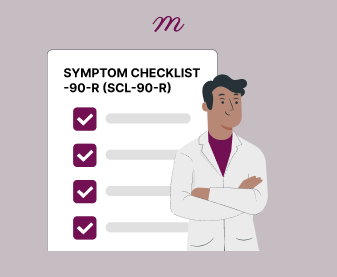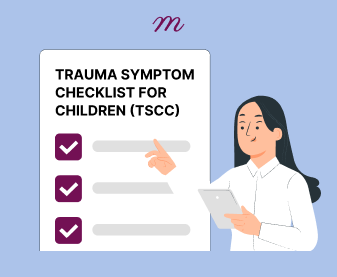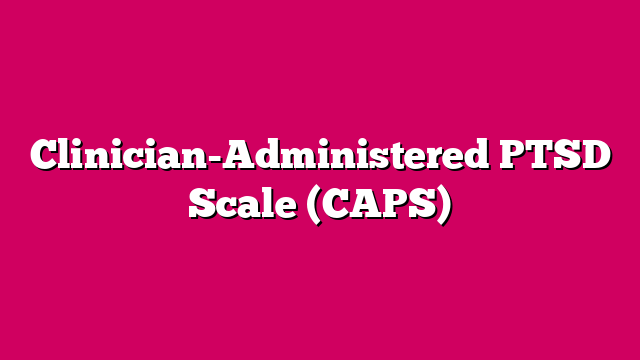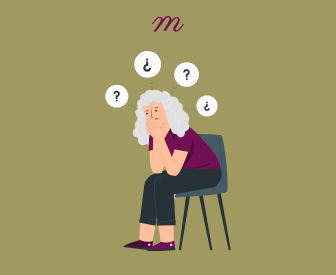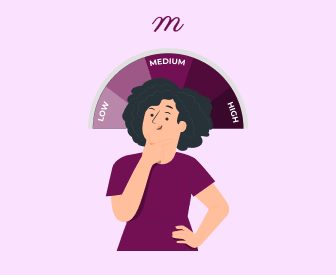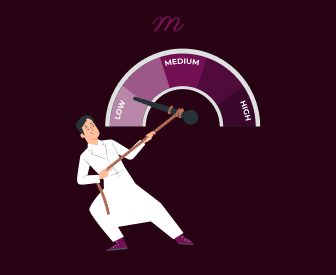Have your progress notes written for you automatically
The Symptom Checklist-90-Revised (SCL-90-R) is a powerful tool for uncovering the complexities of psychological distress. Widely used in both clinical and research settings, this self-report questionnaire helps therapists identify and measure symptoms across nine critical dimensions, from depression to anxiety. Its versatility and ease of use make it a go-to assessment for gaining a deeper understanding of clients' mental health.
For mental health professionals, the SCL-90-R is more than just a screening tool—it’s a gateway to more informed and tailored care. By highlighting symptom patterns and tracking changes over time, it supports evidence-based treatment planning and meaningful client progress. With its broad applications, the SCL-90-R remains a cornerstone of effective psychological assessment.
What is the SCL-90-R?
The Symptom Checklist-90-Revised (SCL-90-R) is a comprehensive psychological assessment tool designed to evaluate a wide range of psychological symptoms and distress [1]. As a multidimensional self-report instrument, it enables clients to reflect on their emotional and psychological well-being by rating their experiences across 90 items. These items provide insights into various symptom dimensions, such as depression, anxiety, and interpersonal sensitivity, making the SCL-90-R a valuable resource for mental health professionals.
Originally developed in the 1970s by Leonard R. Derogatis, the SCL-90-R builds upon its predecessor, the Hopkins Symptom Checklist (HSCL), offering a more extensive and nuanced approach to symptom evaluation. Its purpose is to identify and assess psychological symptoms across multiple domains, providing a clear picture of a client’s mental health status. Beyond initial assessment, the SCL-90-R is widely used to monitor symptom changes over time, making it a cornerstone in evidence-based practice for both clinical and research applications.
Structure of the SCL-90-R
The Symptom Checklist-90-Revised (SCL-90-R) is a 90-item self-report questionnaire designed to assess psychological distress and symptoms. Each item is rated on a 5-point Likert scale, ranging from 0 (not at all) to 4 (extremely), allowing clients to express the intensity of their symptoms over the past week. This straightforward design ensures ease of use while capturing a detailed picture of a client’s mental health.
The SCL-90-R evaluates nine primary symptom dimensions, offering a comprehensive view of psychological functioning:
- Somatization: Physical complaints linked to psychological distress.
- Obsessive-Compulsive: Intrusive thoughts and repetitive behaviors.
- Interpersonal Sensitivity: Discomfort in interpersonal interactions.
- Depression: Symptoms such as sadness, hopelessness, and low motivation.
- Anxiety: Feelings of tension, nervousness, and panic.
- Hostility: Aggressive and irritable behaviors.
- Phobic Anxiety: Intense fear or avoidance of specific situations.
- Paranoid Ideation: Suspiciousness and mistrust of others.
- Psychoticism: Indicators of disorganized thinking and perception.
In addition to these domains, the SCL-90-R provides three global indices that offer a broader assessment of psychological distress:
- Global Severity Index (GSI): Reflects overall psychological distress.
- Positive Symptom Distress Index (PSDI): Measures the intensity of reported symptoms.
- Positive Symptom Total (PST): Counts the number of symptoms reported as present.
This multidimensional structure makes the SCL-90-R a robust tool for identifying symptom patterns and tracking progress in clinical and research settings.
Validity and Reliability
The SCL-90-R is considered a valid and reliable measure of psychological distress, with high internal consistency and test-retest reliability across various populations, including clinical and nonclinical groups [2, 3]. However, its factor structure has been questioned, with some studies suggesting that it measures one large factor rather than distinct dimensions, commonly referred to as global psychological distress [4, 5].
Also, the tool is primarily used to assess general psychological distress rather than specific psychopathologies, due to its inability to adequately discriminate among clinical diagnoses [3]. Despite these concerns, the SCL-90-R remains a useful tool for measuring psychological status and screening for mental disorders.
Administration and Scoring
Who Can Administer the SCL-90-R?
The Symptom Checklist-90-Revised (SCL-90-R) should be administered and interpreted by licensed mental health professionals or individuals under their supervision. Proper qualifications ensure that results are used appropriately to inform clinical decisions. Familiarity with psychological assessment and experience in interpreting standardized tools are essential for accurate evaluation.
Process of Administration
The SCL-90-R is a client-completed questionnaire that takes approximately 12–15 minutes to complete, making it a time-efficient option for psychological assessment. It can be administered in various settings, including clinical practices, research studies, and outpatient programs. The tool is flexible and can be completed on paper or digitally, depending on the resources available. To ensure accurate results, it is important to provide clear instructions and a private, comfortable environment for clients.
Scoring and Interpretation
Scoring the SCL-90-R involves calculating raw scores for each of the nine symptom dimensions and the three global indices. Raw scores are then compared to clinical norms to determine the severity of symptoms. These norms are based on data from diverse populations, enabling clinicians to contextualize results and identify areas requiring attention.
Interpreting SCL-90-R scores requires professional judgment to consider the client’s unique circumstances and any external factors influencing their responses. While the tool provides valuable insights, it is not a diagnostic instrument and should be used alongside other assessments and clinical interviews to ensure a comprehensive understanding of the client’s mental health. After scoring the SCL-90-R, discussing the results with clients can provide valuable insight into their symptoms and treatment goals. Therapists should present the findings in a client-friendly manner, using the data to promote understanding and encourage active participation in the therapeutic process.
Clinical Applications
Uses in Therapy and Research
The Symptom Checklist-90-Revised (SCL-90-R) is a versatile tool used to screen for psychological distress and evaluate the severity of symptoms across various domains. Its structured format allows therapists to quickly identify areas of concern, making it an excellent starting point for clinical assessments. Additionally, the SCL-90-R is highly effective for monitoring changes in symptoms over time, providing measurable data to evaluate treatment progress and the effectiveness of interventions. In research settings, it serves as a reliable measure for studying psychological distress in diverse populations and examining the impact of therapeutic approaches.
Benefits for Therapists
For therapists, the SCL-90-R offers invaluable insights into a client’s psychological state. By highlighting symptom patterns and severity, it helps clinicians understand the scope of a client’s challenges and tailor treatment plans accordingly. This individualized approach can enhance the therapeutic process by targeting the most pressing concerns. Moreover, the ability to track symptom changes over time allows therapists to refine interventions based on the client’s progress, fostering a more dynamic and responsive treatment process.
Common Populations
The SCL-90-R is primarily used with adults in various settings, including clinical practices, outpatient programs, and research studies. It is especially useful for clients experiencing a broad range of psychological symptoms, from mild distress to more severe mental health conditions. Its flexibility and comprehensive scope make it a trusted tool for professionals working with diverse populations in both clinical and academic environments.
Strengths and Limitations
Advantages
The Symptom Checklist-90-Revised (SCL-90-R) stands out for its comprehensive coverage of psychological symptoms, making it a versatile tool in clinical and research settings. With its 90 items spanning nine distinct symptom dimensions, it provides a holistic view of a client’s psychological distress. Additionally, the self-report format and straightforward 5-point Likert scale make the SCL-90-R easy to administer and interpret, ensuring accessibility for both clients and professionals. Its time-efficient nature further enhances its practicality in busy clinical environments.
Cultural and Linguistic Adaptations
One of the strengths of the SCL-90-R is its availability in multiple languages, making it suitable for use in cross-cultural research and practice. This adaptability allows clinicians to assess symptoms accurately in diverse populations while maintaining cultural relevance. It has been widely translated and validated in various regions, ensuring its effectiveness across different linguistic and cultural contexts.
Validation and Reliability
The SCL-90-R boasts high levels of validity and reliability, supported by decades of research and clinical use. Studies consistently demonstrate its ability to measure psychological symptoms accurately and reliably across different populations. These qualities make it a trusted and scientifically grounded instrument for assessing psychological distress, whether used for individual treatment or broader research initiatives.
Limitations
While the Symptom Checklist-90-Revised (SCL-90-R) is a valuable tool, it is not without limitations. As a self-report measure, it is susceptible to biases such as social desirability or malingering, where clients may underreport or exaggerate symptoms. Additionally, the overlap between symptom domains can sometimes complicate interpretation, as certain items may relate to multiple dimensions, making it challenging to pinpoint specific issues.
Not a Diagnostic Tool
A key limitation of the SCL-90-R is that it is a screening tool, not a standalone diagnostic measure. While it offers valuable insights into psychological symptoms and distress, it should not be used to diagnose mental health disorders. Clinicians must combine SCL-90-R results with other assessments, clinical interviews, and professional judgment to develop an accurate and comprehensive understanding of a client’s mental health.
Need for Cultural Sensitivity
Despite its wide use, the SCL-90-R requires careful consideration of cultural context to ensure its relevance and accuracy across diverse populations. Cultural norms, language nuances, and varying expressions of psychological distress can influence responses. To mitigate these issues, clinicians must consider cultural adaptations and interpretations when using the tool, especially with clients from different backgrounds.
Short Versions and Adaptations
Over time, several shortened versions of the SCL-90-R have been developed to address the need for more time-efficient and context-specific assessment tools. These adaptations retain some of the core strengths of the original while offering practical options for research and clinical applications. Notable examples include the Brief Symptom Inventory-18 (BSI-18), which evaluates psychological distress across 18 items and is widely used in both clinical and non-clinical settings. Other versions have demonstrated satisfactory validity in specific populations [6, 7].
For targeted screenings, tools like the SCL-10 provide rapid assessments with just 10 items, making them ideal for initial evaluations or large-scale studies where administration time is limited. While these shorter forms are valid and reliable for specific purposes, they lack the comprehensive scope of the full SCL-90-R and may omit critical symptom dimensions. As such, these adaptations are best suited for preliminary screenings or situations requiring efficiency, while the full SCL-90-R remains the preferred tool for thorough assessments and treatment planning.
Wrapping Up: Why the SCL-90-R Matters
The Symptom Checklist-90-Revised (SCL-90-R) is a vital tool for understanding and addressing psychological distress. Its comprehensive coverage of nine symptom dimensions provides mental health professionals with actionable insights to guide treatment planning and track progress. Widely trusted in both clinical and research settings, the SCL-90-R’s reliability and ease of use make it indispensable for addressing diverse mental health needs.
More than just a screening tool, the SCL-90-R fosters a collaborative therapeutic process by highlighting symptom patterns and changes over time. Its versatility and evidence-based design ensure its ongoing relevance in helping therapists deliver effective, client-centered care in an ever-evolving mental health landscape.
References
[1] Derogatis, L. (1975). The Symptom Checklist-90-R (SCL-90-R).
[2] Schmitz, N., Hartkamp, N., Ki-Use, J., Franke, G., Reister, G., & Tress, W. (2000). The Symptom Check-List-90-R (SCL-90-R): A German validation study. Quality of Life Research, 9, 185-193. https://doi.org/10.1023/A:1008931926181
[3] Hildenbrand, A. K., Nicholls, E. G., Aggarwal, R., Brody-Bizar, E., & Daly, B. P. (2015). Symptom Checklist-90-Revised (SCL-90-R). The Encyclopedia of Clinical Psychology, 1–5. https://doi.org/10.1002/9781118625392.wbecp495
[4] Grande, T., Newmeyer, M., Underwood, L., & Williams, C. (2014). Path Analysis of the SCL-90-R. Measurement and Evaluation in Counseling and Development, 47, 271 – 290. https://doi.org/10.1177/0748175614538061
[5] Urbán, R., Kun, B., Farkas, J., Paksi, B., Kökönyei, G., Unoka, Z., Felvinczi, K., Oláh, A., & Demetrovics, Z. (2014). Bifactor structural model of symptom checklists: SCL-90-R and Brief Symptom Inventory (BSI) in a non-clinical community sample. Psychiatry Research, 216, 146-154. https://doi.org/10.1016/j.psychres.2014.01.027
[6] Sereda, Y., & Dembitskyi, S. (2016). Validity assessment of the symptom checklist SCL-90-R and shortened versions for the general population in Ukraine. BMC Psychiatry, 16. https://doi.org/10.1186/s12888-016-1014-3
[7] Müller, J., Postert, C., Beyer, T., Furniss, T., & Achtergarde, S. (2010). Comparison of Eleven Short Versions of the Symptom Checklist 90-Revised (SCL-90-R) for Use in the Assessment of General Psychopathology. Journal of Psychopathology and Behavioral Assessment, 32, 246-254. https://doi.org/10.1007/S10862-009-9141-5


